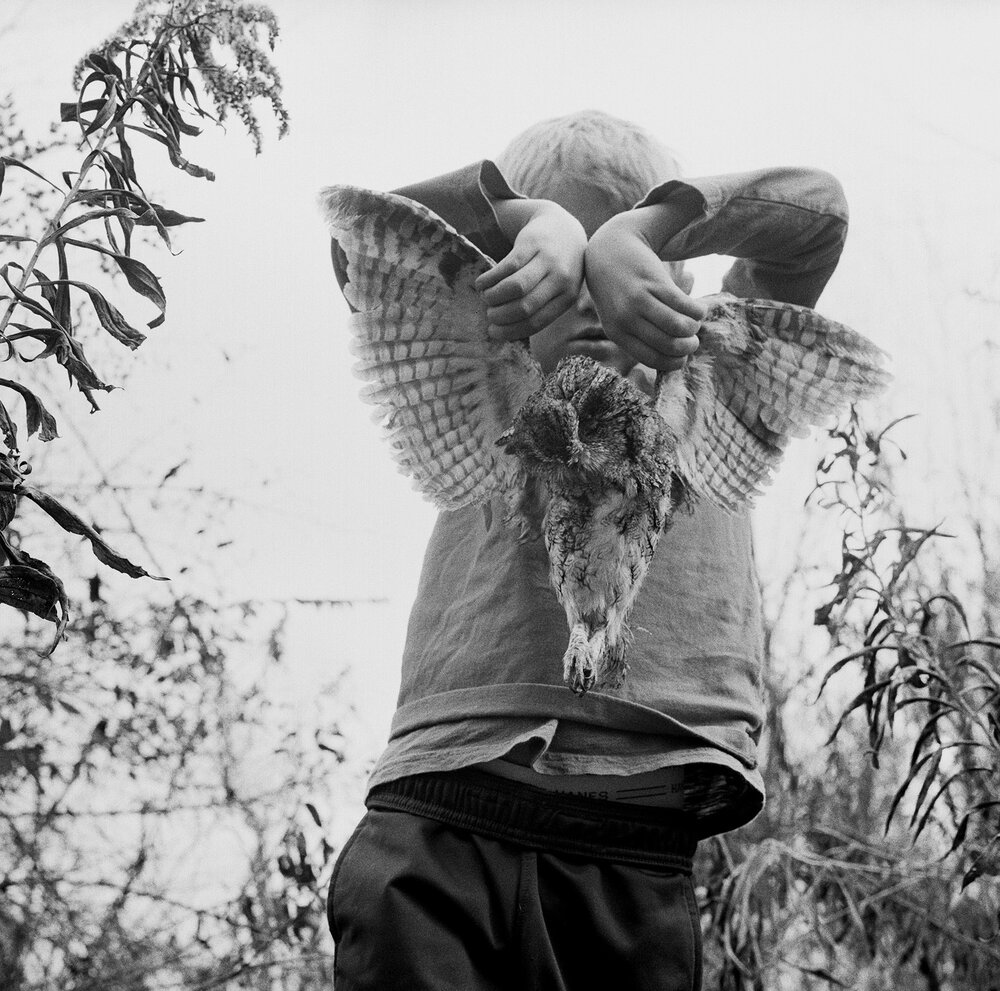 |
The Locusts. By Jesse Lenz.
|
Photographs by Jesse Lenz
Charcoal Press, Ohio, 2020. 144 pp., 9¾x12¼".
For photographers of the teeming, public world — sometimes labeled street photographers, social documentarians, or photojournalists — a challenge exists: How small can something be in the photographic frame while still functioning as the nominal subject? Robert Capa advocated for proximity — "if the photograph isn’t good enough, you’re not close enough” was his refrain — while others, like Helen Levitt, Henri Cartier-Bresson, or Garry Winogrand, kept their distance and offered contextual tableaux instead of spotlights.
The issue expands beyond the photographer’s fascination with the thing itself. In the case of Winogrand’s project leading to his book The Animals, while photographing animals in a zoo, he inevitably captured people in the pictures. Humans, in fact, often appear closer to the observer than the animals. The title hints at the truth of “both/and” — both humans and zoo occupants are animals, and our behaviors bear comparison. Ultimately, the story is about the porous relationships between species.
Such a continuum energizes Jesse Lenz’ The Locusts. One might even consider the similarities of the titles and compare how the relative sizes of animals and insects increase the stakes of the game; contrasting humans with insects instead of larger quadrupeds implies a new calibration. Locusts, individually, are difficult to make large in the frame without either a macro lens or post-exposure cropping. And the world around this family seems very expansive. Most of the humans to come appear just out of reach, the photographer maintaining a respectful, curious remove.
Throughout The Locusts, homo sapiens share the stage with various creeping, running, hopping, and airborne species. Our collective presence in these pictures has a very light touch. Often the ostensible subject of a photograph is nearly imperceptible. Some examples:
A beehive, or a squirrel’s nest, is little more than a baby pea suspended in a mesh of brush and saplings. An arch-necked crane that would be imperceptible if not for the white ‘S’ contrasting the marsh. A deer, dashing across the far edge of a field, hovers mid-leap against the arboreal dark. Children roam across broad expanses. The clutch of a black-cloaked young woman, raven-esque and approaching us, seems to float over the ground. An infant stuffed in a snowsuit resembles a spacewalker lifting off from the floor. A slightly older child disappears into a snowbank that resembles a cumulus cloud. In one image, a riff on Gill’s Pillar conceit, a bird of prey lifts off a fencepost. Within the frame, the bird appears as little more than a forsythia petal, an avian bit of dandelion fluff carried away by the wind.
 |
Light flows in from behind many of the subjects, leading to overexposed backgrounds that imbue the images with airy haze. (One might be pardoned for seeing “Lenz” flares.) The natural light surrounding these bucolic spaces is a glorifying light. Not god-like, exactly; not like the clouds parting to usher heavenly spotlights earthward. Nonetheless, there is gratitude in the light, an admission of comfort within the chaos.
Lenz mingles “lux et levitas”, grace with gravitas. (Pardon my truly lighthearted pun on Yale’s motto.) Only dead things — a chicken’s head, a cat in a casket, a skeleton decaying into the dirt, a still glistening placenta — are notably weighted. The existential extension of that heaviness is surprisingly pervasive. Faces of children are often somber or pensive — as in the tipped-in image on the cover. A primitive deer stand, inked against the open sky, looms at the edge of a field, awaiting the aforementioned airborne whitetail that appears two pages later.
As many radiantly backlit images as there are in The Locusts, memento mori and existential angst are in ample supply. Dave Heath’s lyrically despairing A Dialogue with Solitude (1965) filters through Lenz’ photographs. A solitary house, presumably the family residence, glows in a darkness that is either dusk or storm. A dozen sheep, heads down and foraging, spot the middle ground. Roofs of outbuildings glint in arboreal shadow.
 |
Lenz made these photographs over a three-year period, finishing in 2020. The sequencing and design of this book effectively jumble any easy reading of this family’s emotional landscape. Because the book’s sequence isn’t chronological, and because three years is a long time in the lives of children, we lack the luxury of certainty. The cast of characters swim in and out of focus before us. Infants become toddlers, tweens attain puberty and approach drivers’ ed classes.
Lenz embraces these scenes fondly and gently, sometimes swooping within arm’s reach, sometimes standing apart, sometimes projecting into deep space to capture a fleeting expression of nature. All the while he tests the significance of bonds, examines relationships of scale as measured in proportion and wonder, and uses photography to express something like love.
Purchase Book
Read More Book Reviews
Purchase Book
Read More Book Reviews
 |
 |
 George Slade, aka re:photographica, is a writer and photography historian based in Minnesota's Twin Cities. He is also the founder and director of the non-profit organization TC Photo. rephotographica.com/
George Slade, aka re:photographica, is a writer and photography historian based in Minnesota's Twin Cities. He is also the founder and director of the non-profit organization TC Photo. rephotographica.com/Image c/o Randall Slavin










